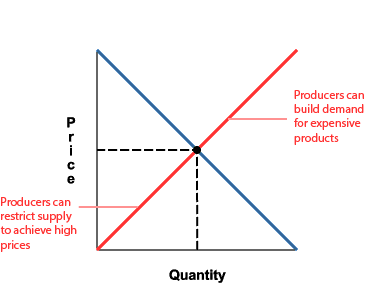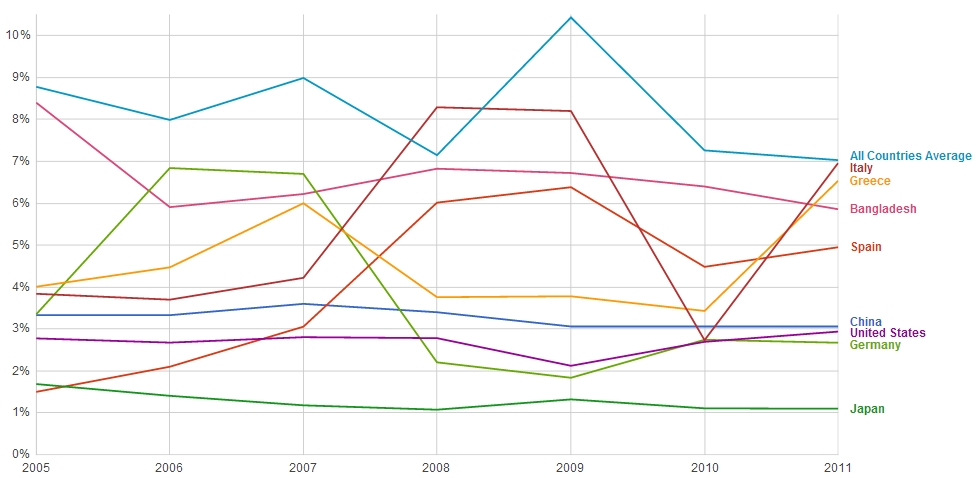The Marshallian Supply and Demand Fallacy
November 18, 2013 17 minutes • 3477 words
Table of contents
This is the early version of my Fallacy of Market Equilibrium Post that was sent to a journal but was not accepted. This led me to post to the internet instead.
Juan
The Cause of Crises
The arbitrariness created by selfish interests, combined with the impossibility of knowing everything, allows nominal value to be created from nowhere, just as easily as they can be written by a “bookkeeper’s pen” (Friedman, 1969).
This lets such value vanish just as quickly during periods of value-correction called crashes and recessions.
Such a system resembles a game with players competing for points in the form of money.
All games must have winners and losers, and are never satisfied with a draw. Thus, even if buyers and sellers may come to an agreement or “equilibrium” (a draw), sellers will still endeavor to win and create imbalance to their advantage.

The lack of a measure of real value corrupts the game by allowing profiteers (powerful players) to conspire to command nominal prices (points) or regulations (in-game rules) through bribing, lobbying, hoarding, inducing scarcity, and exploitation of workers by their masters:
This game was then visualized through Alfred Marshall’s Partial Equilibrium, which became the foundation of microeconomics.
In this theory, the lack of any concrete measure of value is offset by the fact that buyers and sellers would somehow find “equilibrium” prices all the time if everything else stays the same (ceteris paribus) every time.
This was a fallacy that was known to many intellectuals in the 1700’s, especially Adam Smith:
To Smith, the “Law of Demand” need not follow any mathematical equilibrium. He blames vested interests for its corruption:
As the “Law of Demand” is independent of any equilibrium, it is therefore the “Law of Supply” that is subordinate and dependent on it:
A free society, one that is not controlled by vested interests, thus has an independent demand curve. The subjective and arbitrary valuations of producers, represented by the wages and profits they desire, are contained in the producer’s selling price, which Smith calls the “natural price”:
This has a qualitative measure (high or low price), distilled into the simple equation:
Non-arbitrary (production cost) + Semi-arbitrary (rent, wages and profits) = Natural Price
Unlike the natural price which is qualitative (y-axis), the market price (the price perceived by buyers who are always seeking the lowest price), is quantitative (x-axis):
Free competition reduces the arbitrariness of wages and profits, allowing natural prices to fall to the lowest level demanded by society, and thus satisfy all, both sellers and buyers:
The graph below shows Marshall’s supply curves (red lines) and Smith’s Natural Price supply curves (green lines).

Let us say one baker sees a demand for donuts.
He produces 5 units at a “natural” selling price of $2 each (light green line). This includes an ordinary arbitrary profit of $1 per unit which he is satisfied with, on top of the production cost (green line).
He finds that all of his donuts are sold (Point A).
He then has two choices:
- Increase the price or
- Increase the quantity sold
If he has a selfish or monopolistic interest, he will slowly raise prices, or do “groping” until he finds the highest price with which he can sell all 5 donuts without inviting competition. This is the monopolistic price (vertical red line at Point B).
In such a case, competition will sooner or later emerge which will force him to lower his price to $3 (Point D).
Most commonly, and more naturally, he will produce more donuts until all demand is satisfied. In this case, it is between 7-8 units with ordinary (Point C) or even no profits (where the green lines intersect with the blue demand line), lest the demand be satisfied by competitors or his customers complain of his frequently-changing prices.
A profit-maximizing marginalist baker would bake 5 donuts and price them at $4 each, for a total profit of $15 (54, less 51). This benefits a total 6 people (including himself).
A socially-minded baker, on the other hand, would bake 7 donuts at a price of $2 each, for a total profit of $7 (72 less 71), benefiting a total of 8 people in his society, or all the people interested in donuts.
Adam Smith’s supply curve would therefore benefit more people and address all demand without compromising product quality, at the expense of lesser profits at ordinary rates.
| Seller | Quantity Served | Profit to Baker | People Benefited |
|---|---|---|---|
| Marginalist with Monopoly | 5 | $15 | 6 |
| Marginalist with Competition | 6 | $12 | 7 |
| Socially-minded Baker | 7 | $7 | 8 |
If applied in a bigger scale, this would support his assertion that the earth’s resources would be able to benefit all humans if allocated in a socially-minded way:
Instead of being in equilibrium, Smith’s market prices are realistically flexible, being either “above (high profits), or below (low profits), or exactly the same with its natural price (ordinary profits)”:
As Capitalism is based purely on profits which are unstable by nature, “uncertainty” or “not knowing the future” becomes an unnecessarily big issue in current economics.
The Inverse Relationship of Development and Profits
To Smith, one of the things certain about profits is that there is an inverse relationship between the profits of merchants and the wealth of societies:

| Status | Country | Market Interest Rate in 1700’s |
|---|---|---|
| Fast Advancing* | Holland | 2-3% |
| Advancing | Englahd | 3-5% |
| Slowly Advancing | France | 5% |
- early in the mercantile period
| Status | Country | Change in Interest Rate Spread 2005 vs 2012 |
|---|---|---|
| Advancing | Bangladesh | -2.54 |
| Slowly Advancing | Germany | -0.68 |
| Slowly Advancing | Japan | -0.59 |
| Slowly Advancing | China | -0.29 |
| Stagnating | US | +0.16 |
| Declining | Italy | +3.12 |
| Declining | Spain | +3.45 |
| Rapidly Declining | Zimbabwe (2005-2009) | +281.75 |
As free competition produces the lowest profits, selfish-interests find themselves trying lower their costs below the ordinary rates by:
- lowering wages, evading taxes, fighting regulation, causing negative externalities, etc, or
- raising prices through monopoly by lobbying for unfair advantages, acquiring smaller competitors, and enforcing what Smith calls “secrets in manufactures” such as intellectual property and information asymmetry.
The best and most sustainable way to raise profits then, as today, was through innovation and the expansion to new markets:
The acquisition of new territory, or of new branches of trade, may sometimes raise the profits of stock, and with them the interest of money, even in a country which is fast advancing in the acquisition of riches…Part of what had before been employed in other trades, is necessarily withdrawn from them, and turned into some of the new and more profitable ones.
In all those old trades, therefore, the competition comes to be less than before. The market comes to be less fully supplied with many different sorts of goods. Their price necessarily rises more or less, and yields a greater profit to those who deal in them, who can, therefore, afford to borrow at a higher interest….The great accession both of territory and trade, by our acquisitions in North America and the West Indies, will sufficiently account for this..
Unfortunately, selfish-interests would rather raise prices by establishing corporate monopolies:
and by going against the interests of the rest of society, even to the point of oppression:
To widen the market may frequently be agreeable enough to the interest of the public; but to narrow the competition must always be against it, and can serve only to enable the dealers, by raising their profits above what they naturally would be, to levy, for their own benefit, an absurd tax upon the rest of their fellow-citizens.
The proposal of any new law or regulation of commerce which comes from this order, ought always to be listened to with great precaution, and ought never to be adopted till after having been long and carefully examined, not only with the most scrupulous, but with the most suspicious attention. It comes from an order of men, whose interest is never exactly the same with that of the public, who have generally an interest to deceive and even to oppress the public, and who accordingly have, upon many occasions, both deceived and oppressed it.
| Law | Cause | Effect |
|---|---|---|
| Smoot–Hawley Tariff Act | Lobbying by American Farmers | Fueled the Great Depression |
| Plaza Accord | Lobbying by Caterpillar | Japan Asset Price Bubble |
| Repeal of Glass-Steagal | Lobbying by Citigroup | Subprime Crisis |
Thus, Smith clearly shows that the interests of corporations and those who live by profit are against the interests of societies, something that the ancient Chinese knew, and perhaps was the reason why they regarded the merchant class as the lowest class in Chinese society:
A supply curve with a social outlook chases demand, new markets, and encourages production and innovation unlike Marshall’s supply curve which stifles competition, withholds production, or coaxes demand to buy at higher prices. Smith’s supply curve will look like a production cost curve in the short run, and a Keynesian supply curve in the long run as business interests will be in line with the interest of societies and governments.

Because of the corruption of the “law” of demand and supply, people who follow the current economic theory struggle against each other:
As this “absurd doctrine” is unnatural, it has necessitated the creation of unrealistic concepts such as “perfect rationality”, “perfect competition”, and “perfect information” and created economic puzzles (Obstfeld and Rogoff, 2001).
Economists blame the public for “irrational exuberance” and accuse the government of not allowing perfect competition or companies for “information asymmetry” even though no economist has been able to give any real solutions even in this age of supercomputers.
In reality, the doctrines of the marginal revolution created arbitrariness simply to allow profit maximization so that each person can realize one’s pleasures more quickly while disregarding its negative effects on others, a symptom present among selfish people.
Had there been a real measure of value, with empowerment and free competition, then the realization of one’s pleasures would have been delayed by the natural course of commerce, dependent on many other factors.
The marginalists created mathematical “get-rich-quick” supply curves that, instead of producing the most quantity to satisfy demand, focuses merely on taking advantage of the numerical gap between high and low prices, something that merchants naturally do.
Such a mercantile system expectedly creates a few big winners, many losers, rapid economic booms, and severe busts, all in a climate of animosity—a system now called Capitalism.






